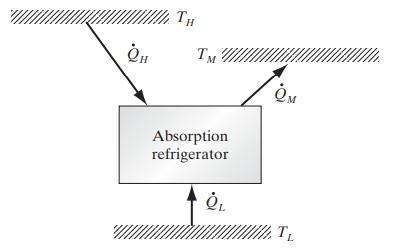Forest cabins, remote mobile homes, Amish farms, and residential structures in locations where electricity is not available
Question:
Forest cabins, remote mobile homes, Amish farms, and residential structures in locations where electricity is not available are often equipped with absorption refrigerators that rely on changes from absorption at low temperatures to desorption at high temperatures to produce pressure changes in a refrigeration system instead of a compressor. The energy source for such refrigeration systems is a flame, typically produced by propane or another fuel. The most common absorption refrigeration working fluid is the ammonia-water system.
The only patent ever awarded to Albert Einstein was for an absorption refrigeration design.
The simplest representation of an absorption refrigeration is given in the figure below. The energy flows in such a device are a high-temperature (TH) heat flow (Q̇H) that supplies the energy for the refrigerator, a low-temperature (TL) heat flow (Q̇L) into the condenser of the refrigeration cycle extracted from the cold box of the refrigerator, and a moderate-temperature (TM) heat flow (Q̇M) out of the refrigerator.

a. Compute the coefficient of performance for an absorption refrigerator defined as

assuming that the absorption refrigeration cycle is reversible.
b. Calculate the maximum coefficient of performance that can be achieved if heat transfer from the flame occurs at 750◦C, the ambient temperature near the refrigerator is 27◦C, and the temperature inside the refrigerator is −3◦C.
Step by Step Answer:

Chemical Biochemical And Engineering Thermodynamics
ISBN: 9780470504796
5th Edition
Authors: Stanley I. Sandler





